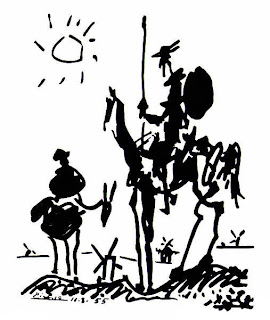Pablo Picasso painted Don Quixote in 1955, and it is one of his more well-known paintings. Don Quixote features the characters Don Quixote de la Mancha and his sidekick, Sancho Panza, which are characters from the story by Miguel de Cervantes. The novel, Don Quixote, tells the tale of a man named Alonso Quijano, who reads so any heroic novels that he sets out to become one himself under the name Don Quixote. Alonso appoints a simple farmer, Sancho, to be his squire. The name, Don Quixote, means talented defender or gifted saviour.
Unlike his previous paintings, Picasso's Don Quixote seems like a simple black and white sketch. His previous paintings contained multiple color schemes and symbolism. However, Don Quixote seems to hold more power than the rest. The featured figures look deformed but dramatic. Picasso grasps the fatigue and weariness that the reader feels in Don Quixote. In addition, it seems that the figures in Don Quixote were changed many times before final completion. Don Quixote, on the right of the painting, has a thin neck that connects his head to his rather large body. Compared to Panza, who sits on the left, Don Quixote looks ragged and malnourished. Nonetheless, Picasso captures his audience's attention in Don Quixote with an overall attractiveness and a "bright humor."
A link for the novel, Don Quixote, is below if you would liked to read a summary of the story Picasso based this painting on.
Source
Don Quixote
Don Quixote - Novel

Apr
22
"Don Quixote"
Pablo Picasso painted Don Quixote in 1955, and it is one of his more well-known paintings. Don Quixote features the characters Don Quixote de la Mancha and his sidekick, Sancho Panza, which are characters from the story by Miguel de Cervantes. The novel, Don Quixote, tells the tale of a man named Alonso Quijano, who reads so any heroic novels that he sets out to become one himself under the name Don Quixote. Alonso appoints a simple farmer, Sancho, to be his squire. The name, Don Quixote, means talented defender or gifted saviour.
Unlike his previous paintings, Picasso's Don Quixote seems like a simple black and white sketch. His previous paintings contained multiple color schemes and symbolism. However, Don Quixote seems to hold more power than the rest.
Unlike his previous paintings, Picasso's Don Quixote seems like a simple black and white sketch. His previous paintings contained multiple color schemes and symbolism. However, Don Quixote seems to hold more power than the rest.
Mar
25
"Self Portrait"
Picasso painted his second self portrait while he was working on another piece, Les Demoiselles d'Avignon. Painted in 1907, Picasso created this piece after he decided to take a break from working on Les Demoiselles. Besides this self portrait, Picasso also did another self portrait in 1901during his Blue Period.
The face of Picasso reflects the faces in Les Demoiselles d'Avignon. Having a three-dimensional sculpture quality, both the Demoiselles and Picasso faces seem something like a statue.
The face of Picasso reflects the faces in Les Demoiselles d'Avignon. Having a three-dimensional sculpture quality, both the Demoiselles and Picasso faces seem something like a statue.
Mar
4
"Asleep"
The woman in Asleeep, painted in 1932, is again Marie Therese, Picasso's mistress. The two colors red and green are so bold and intense that they accentuate the tranquility of Marie Therese while sleeping. Like the women in Picasso's neoclassical period, Marie does not have any "expression or character" written on her face. Instead, her face is almost unpleasantly sizable and unchanging, which is how the women were portrayed during that period of Picasso's painting.
Feb
26
"Girl Before A Mirror"
Pablo Picasso painted Girl Before A Mirror in March of 1932. Unlike The Old Guitarist, this painting is a part of Picasso's cubism period. The girl featured in the painting is Marie Therese Walter, who was a mistress of Picasso. She is featured in a number of Picasso's paintings. Seeing as that the subject of the painting is secret lover, some critics consider Girl Before a Mirror to be "erotic."
Mirror is a bright and bold painting.
Mirror is a bright and bold painting.
Feb
11
"The Old Guitarist"
Picasso painted The Old Guitarist in 1903 following the suicide of his best friend, Casagemas. Because of his friend's death, Picasso became more sensitive and sympathetic towards the hardships of the ill-treated. He started to paint pictures portraying the sick, the miseries of being poor, and the ostracized. Seeing as he had been less fortunate the prior year, Picasso found that he had an easy time portraying his ideas and thoughts.
The Old Guitarist was a part of Picasso's Blue Period.
The Old Guitarist was a part of Picasso's Blue Period.

View comments